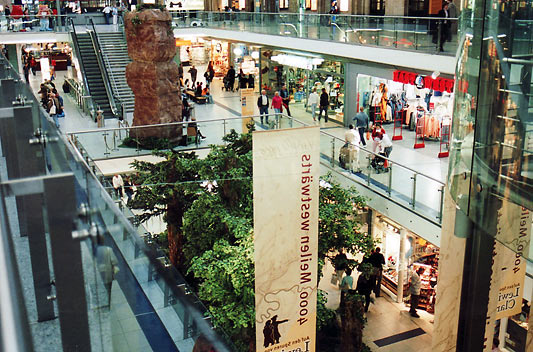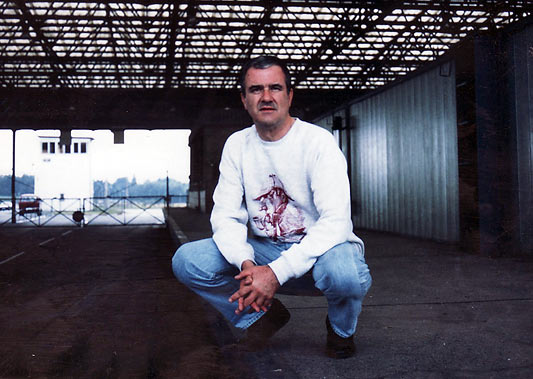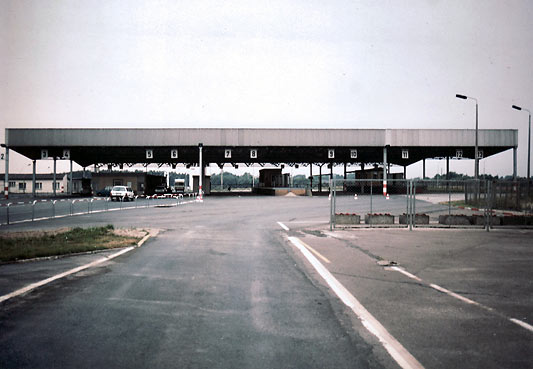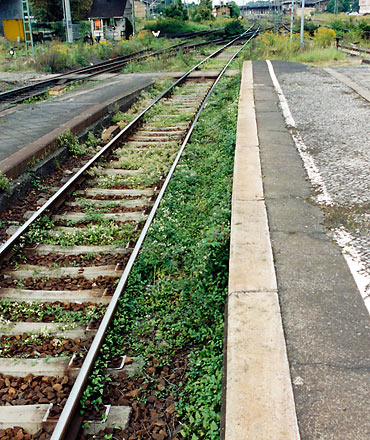|
Stasi History:
A Big Part of East Germany
Photos and story by John Clayton
 he
skies were dark and cloudy and the echoes of thunder could be heard
in the distance. It was a cold and somber date this November day in
1990 as the Deutsche Bahn train in which I was traveling slowly edged
its way into the Leipzig, Germany Hauptbahnhof Central Railway Terminus.
Exactly a year before on November 9th 1989, the Berlin
Wall had been breached, and Germany was working at the speed of
a jetliner to make the previously divided country into one. he
skies were dark and cloudy and the echoes of thunder could be heard
in the distance. It was a cold and somber date this November day in
1990 as the Deutsche Bahn train in which I was traveling slowly edged
its way into the Leipzig, Germany Hauptbahnhof Central Railway Terminus.
Exactly a year before on November 9th 1989, the Berlin
Wall had been breached, and Germany was working at the speed of
a jetliner to make the previously divided country into one.
|
When German reunification took place on October 3rd 1990 after 45
years apart, it was obvious an enormous amount of work had to be
done to bring East Germany up to the same standards as existed in
capitalist West Germany. As but one example, are these train tracks
photographed by John at an East German station in 1992, grass was
STILL growing over and alongside the tracks. "One is so accustomed
to seeing railroad tracks as clean, even sparkling in the sun, and
clear of all detritus," says John, "it was a revelation
to see the shoddy, often dirty conditions in such places as railroad
stations. Not, I’m sure, a high priority on the list of the
Stasi, or anyone in the East German hierarchy, to be smart and good
looking. |
The modern life style enjoyed in West Germany had still
not reached this area of what had been East Germany, and the station
was gloomy, drab and even depressing. But I was wildly excited as this
was the first time travel was available to previously difficult to access
East German destinations. When I looked out the carriage window I saw
most of the railroad tracks into this 19 platform termini were all sprouting
thick, all enveloping grass. The detritus of what had been East Germany
was everywhere, but until 2006 I was not to know about a specific horror
that lay a few blocks from the station.
|

“As noted in my feature,” says John,
“when I first came through the huge Leipzig train mainline
station in 1990, it looked, and was, awful. So when I returned
with a group of fellow US travel journalists in 2004, it was stunning
to see the enormous changes that had occurred. The station has
now become a tourist Mecca and attraction with more shops to buy
clothes, knick knacks, tourist “treasures,” shoes and
on and on, than you think should even be in railroad station.
Surely, this sort of shopping diversity should be in a Shopping
Mall!"
|
|

“As someone who has always been fascinated
by European history, but with special emphasis on “Things
German,” I was thrilled – yes THRILLED – to see
and even explore, my first border crossing between West and East
Germany,” says John. “What was particularly intriguing,”
he says “was the fact that my friends, who were with me in
the car, were West Germans who had to use and go through THIS
crossing on their way to see friends in East Germany. It was,
so they told me, ALWAYS a very creepy and intimidating experience.
So when I decided to roam around this now totally unoccupied by
Stasi border guards, my West German friends were still scared
and wondered if I’d be OK. Obviously I was, but it shows
how deep an impact the Stasi had on both East and West Germans."
|
But there was one enormous building that was exactly
as it had been when it was built in 1913 by the Old Leipzig Fire Insurance
Company. Due to its rounded main corner entrance shape, it bears the
unusual name “Runde Ecke,” and it’s now a museum about
the GDR secret Stasi police, and from 1950 to 1989 it was the headquarters
of the Stasi. When the Re-Unification process began, the Stasi tried
to destroy as much evidence as they could about all the terrifying cruelty
they'd inflicted on their citizens – much of it carried out in
the Runde Ecke building. But thankfully the citizens of Leipzig occupied
the building after the peaceful revolution and saved many of the incriminating
and convicting Stasi documents.
|

This is the Lubeck Border Crossing station. It
shows you how big they were, and with the so many avenues or aisles
to go through – that all needed a large number of Stasi in
attendance – it illustrates how it could well be an intimidating
experience.
|
They also made sure to keep intact much of what this
Stasi building contained so that future generations would understand
the Stasi’s brutal methods. As I walked through its cold corridors
I scrutinized the faded linoleum floors, the brownish yellow wallpaper,
and the folding grills and bars at the doors and windows installed so
that escape was impossible for those destined to die there. As one member
of our US media group said as we exited the building into some most
welcome sunshine, “it sure gave me the heebie jeebies. What a frightening
place."
And yet…
When I toured Dresden’s
The Zwinger, a museum complex housed in a magnificent early 18th-century
palace later on, our guide was an older woman who been born and grew
up in East Germany. I asked her how she liked “being free and able
to do whatever she wanted.” After quite some time she whispered
to me that she preferred “the old ways. Then I had everything provided.
There were no worries. Today, well there is, how do you say it, too
much competition. You understand?”
Related Articles:
Berlin's
Beautiful Bahnhof!; Berlin:
Yesterday and Today; Berlin's
Hoppegarten; The
Great Cities of Germany; Big
City Germany: A Tale of Four Cities; Offbeat
Germany
|



